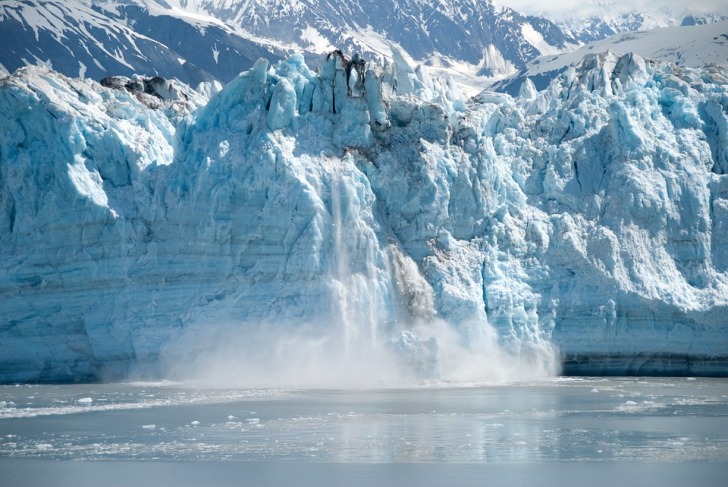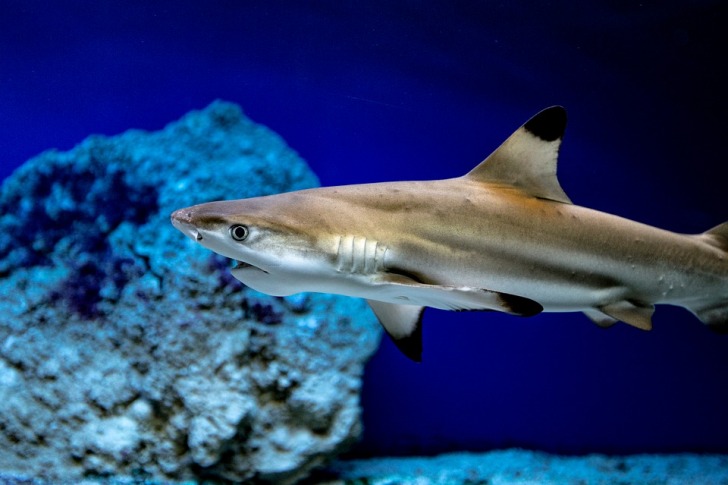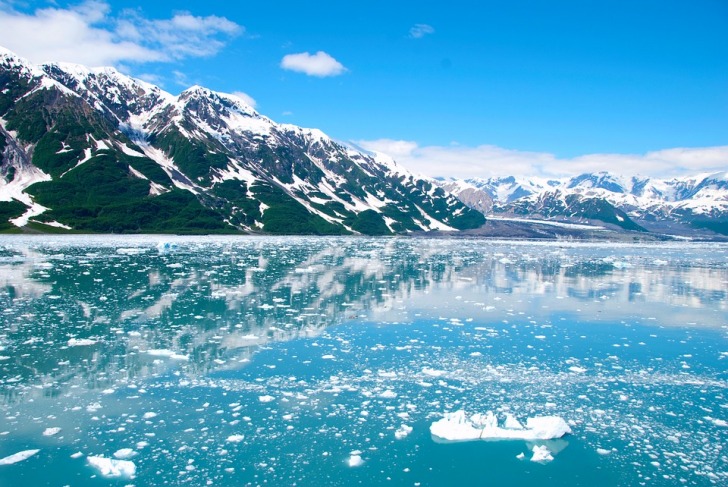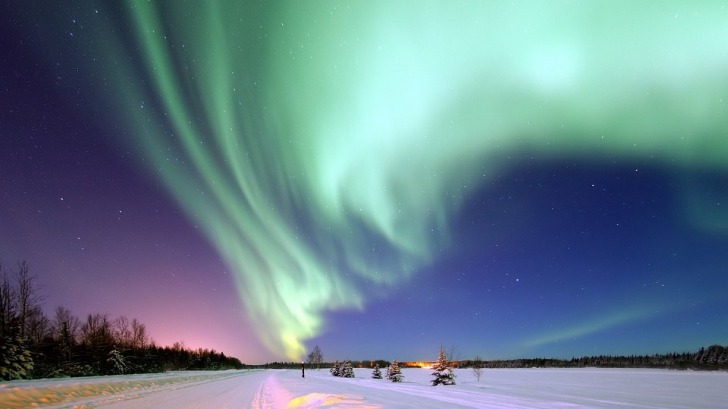Several sharks live and breed in the Pacific Ocean outside of the Alaskan coastline.
Here are the bitter cold waters of the Arctic that freeze out most fish species, including sharks.
Yet you find several sharks adapted to the climate.
Learn more about what kind of sharks you could see when cruising into Alaskan ports, or if you are preparing a fishing expedition to Alaska.
Since there are sharks that live in Alaska, we have included detailed information to help you discover more about shark safety for yourself and the sharks when in Alaska.
Contents
So… Are There Sharks in Alaska?
There sure are!
Several species of sharks are native to Alaska and there are many more that come through the Pacific Ocean outside of the Alaskan coastline.
There are no sharks inside of Alaska continentally because there are only freshwater regions beyond the shore.
Therefore, there are also no freshwater sharks in Alaska that are in the rivers and tributaries, except for the mythological giant Pacific sleeper shark we will get to later.
Alaskan waters are home to Somniosidae, Squalidae, and Lamna ditropis families of sharks.
These are better known as the Pacific sleeper shark, the spiny dogfish, which is also a shark, and the salmon shark.
Each of these shark families lives and breeds in the Arctic and the northern Pacific Ocean around Alaska.
They are adapted to handle the cold temperatures and have been here for tens of millions of years.
Also, if you visit Alaska, you can expect to see great white sharks, six-gill sharks, blue sharks, mackerel sharks, and requiem sharks in the Alaskan waters.

These are the three main types of shark species in Alaska:
- Pacific sleeper shark
- Salmon shark
- Spiny dogfish
Let’s take a look at each of these sharks in a closer perspective.
The Pacific sleeper shark is a more elusive shark species in the Alaskan waters of the Pacific.
This shark spends most of its time in the deep water trawling the floor of the ocean.
Scientists do not know a lot about it.
They have never caught a Pacific sleeper shark that was reproductively mature.
In addition, scientists have yet to figure out a way to determine the age of this shark species.
The traditional methods of determining a shark’s age are not applicable to the body of the Pacific sleeper shark.
It lacks vertebrate bands and dorsal spines that are used to indicate age in sharks.
There have been some reports of the Pacific sleeper shark eating sea lions and other shallow-water swimmers, but for the most part, this shark stays out of the algae limelight.
Size-wise, the Pacific sleeper shark can grow to be up to 14 feet.
Also, an interesting fact, if you eat a Pacific sleeper shark, it is slightly toxic and can make you feel drunk.
The salmon shark is sometimes confused with the great white shark because they are very large in size.
This shark can be found up to 10 feet long and weighs nearly 1,000 pounds.
A popular shark to be found oceans-wide, the Gulf of Alaska is but one home to the salmon shark.
Notice these sharks do breed in the Gulf of Alaska in the summer and fall.
The age of a salmon shark is quite impressive at 30 years.
They also have quite an impressive diet, eating spiny dogfish, which we will meet next, along with salmon, squid, sablefish, and many other Pacific Ocean fish species.
Compare the large salmon shark to the tiny spiny dogfish.
The spiny dogfish is a common shark as there are 119 species as part of the dogfish family.
Spiny dogfish stand out from other sharks in a number of ways.
Pregnant spiny dogfish can carry a fetus shark for up to 24 months, which is a whopping two years.
That is a very long time to be pregnant.
These sharks are called dogfish because they have strong jaws they use to clamp down on prey.
The spiny dogfish also have two spines that contain venom they inject into predators to defend themselves.
These dogfish are a compact shark species that grows up to 39 inches in length for male sharks and 49 inches in length for female sharks.
Here are some additional types of sharks in Alaska:
- Blue sharks
- Great white sharks
- Ground sharks
- Mackerel sharks
- Requiem sharks
- Six-gill sharks
These sharks are not found to be as noticeable in Alaska, but you can see great whites, mackerel sharks, and more in the waters.

Is it Safe to Swim in Alaska?
Swimming in Alaska in the ocean is not recommended unless you have professional experience or guidance.
You will also need to have cold water gear including a wet suit and goggles, as well as flippers, to help you avoid drowning.
The waters are rough and cold, as this is part of the Arctic Circle.
There are a few geographical areas to consider when swimming in the Alaska oceans.
The Beaufort Sea is on the northern border of Alaska where there are no cities dotting the coastline.
This means you are less likely to find access to swimming beaches here.
The Gulf of Alaska, which is more populous with a number of cities, shares the waters with Canada.
Here you have Cordova, Anchorage, Seward, Homer, and Kodiak Island, where swimming would be more appropriate compared to the rest of the state.
These cities are more likely to provide swimming access, including gear rentals and swimming instructors.
To the west coast of Alaska, there is the Bering Sea, along with the Bering Strait that connects the US to Russia, and Bristol Bay, which comes around to the Aleutian Islands.
The Aleutian Islands are home to the Pacific Ring of Fire, and 57 volcanoes.
However, you do not have to worry about volcanic debris falling on your head while in the waters when swimming at this time.
The waters are home to sharks, as well as the keystone species of sea otters, which can play havoc on your lap time.
Duck hunting and fishing are both popular sports, and these involve getting wet and indicate swimming is an option.
Seaducks, puddle ducks, and geese are some of the many waterfowl living in the coastal region of Alaska.
As long as you are prepared to share the waters with these animals, swimming does not appear to be a problem.
Beaches that are recommended for swimming in Alaska include:
- Anchor River State Recreation Area
- Arctic Beach
- Bishop’s Beach
- Black Sand Beach
- Bushkin River Beach
- Caines Head State Recreation Site
- Cannon Beach
- Captain Cook State Recreation Area
- Clam Gulch
- Deep Creek
- Eagle Beach State Recreation Area
- Gold Beach
- Homer Spit
- Kasilof River Beach
- Lowell Point Recreation Site
- Outside Beach
- Rotary Beach
- Wasilla Lake Beach
- Whittier Beach
- Wild Pocket Beaches
If you plan on going to Alaska for a swim, choose one of these beaches.
Treat yourself to the public works and recreational access that each one offers.
You will also be safer when swimming in Alaska if you go to one of these beaches.
There are no reports of issues with shark attacks in Alaska, and there are many shallow coasts on which you can swim safely.
However, deep swimming is not advised unless you are a professional in the warm summer months.
This is due to the currents, cold temperatures, and Arctic wildlife.
Interesting Shark Facts in Alaska
There is only one way to be a shark in Alaska, and that is to be warm-blooded.
Most sharks, as a general rule, are cold-blooded or ectothermic.
Yet five of the species of sharks on this planet are warm-blooded.
This includes the Lamnidae family of sharks, which includes both the salmon shark and the mackerel shark that live in Alaska.
The endothermic abilities of these sharks help them survive the super cold temperatures.
This is especially nice when sharks are swimming in fast waters like shooting bullets.
I imagine the coldness would be like riding a motorcycle at night!

All of the sharks that live in the Arctic waters of Alaska are in saltwater.
There are not any freshwater sharks in Alaska.
The sharks are also predominantly warm-blooded, which allows these shark species to live comfortably in cold water.
Salmon sharks are some of the most warm-blooded sharks of all, with an internal body temperature of 77 degrees F (25 degrees C).
Compare this to the cold-blooded hammerhead, which is “a tropical and warm-temperate species”.
When their body temperature gets too low, they lose muscle function and visual acuity, and their metabolism slows down.
If a shark gets too cold, it cannot keep itself moving and breathe.
In the Gulf of Alaska, the water temperatures average 48 degrees F (9 degrees C) in May, and 55 degrees F (13 degrees C) in June.
Salmon sharks, mackerel sharks, great white sharks, and other warm-blooded sharks are made to live in these waters.
They have the warm blood to help them survive, compared to the cold-blooded cousins of other oceanic fronts.
This being said, there is also the myth that a giant Pacific sleeper shark lives in Lake Iliamna, which is a freshwater lake in Alaska.
3 Safety Tips for Swimming in Shark-Infested Waters
- Do not swim at dawn, dusk, or in the darkness as this is when sharks are feeding and the tides will cause the water level to change.
- If a shark is seen in the water, do not enter or remain in the ocean, even if you have a surfboard or paddleboard for protection as a floatation device. If you see threats of sharks or signs posted by local authorities, believe any warnings and take precautions just to be on the safe side.
- Avoid wearing a sparkly bathing suit with glitter or shiny sunglasses when swimming. These are great reflectors in the sun and appear to look like the shimmer of fish scales or giant squid eyes, in the case of sunglasses.
Summary
Sharks are in Alaska in the saltwater and surf of the Pacific Ocean and the Bering Sea.
However, if you are safe and know what kinds of shark species are out there, including the salmon shark, and can identify their behaviors, you are safer and calmer in the waters.
Sources
- https://www.fisheries.noaa.gov/alaska/ecosystems/shark-research-alaska
- https://www.ktoo.org/2013/08/16/alaska-sharks/
- https://apps-afsc.fisheries.noaa.gov/quarterly/ond2014/divrptsOutreach.htm
- https://seagrant.oregonstate.edu/visitor-center/sharks/pacific-sleeper
- https://wdfw.wa.gov/species-habitats/species/lamna-ditropis#desc-range
- https://oceana.org/marine-life/spiny-dogfish/
- https://alaska.guide/Shark
- https://alaskaduckhuntingguides.com/aleutian-islands-scenery-video/
- https://www.alaska.org/advice/the-best-beaches-in-alaska
- https://www.floridamuseum.ufl.edu/discover-fish/sharks/shark-biology/
- https://biogeodb.stri.si.edu/sftep/en/thefishes/taxon/47
- https://phys.org/news/2020-02-shark-cold-blood-deep.html
- http://www.oceanofk.org/tag/Tagmigrate/ddisttemp.html
- https://seatemperature.info/may/gulf-of-alaska-water-temperature.html
- https://seatemperature.info/june/gulf-of-alaska-water-temperature.html
- https://colors-newyork.com/are-there-sharks-in-the-bering-sea/
- https://www.sidmartinbio.org/how-many-humans-get-killed-by-sharks-a-year/
- https://www.adn.com/features/article/fresh-evidence-alaskas-iliamna-lake-monster-pacific-sleeper-shark-video/2012/06/24/
Going to Alaska?
Read our safety report:
Alaska Safety Overview
READ THE FULL REPORT: Alaska Safety Review
Safety Index:
- OVERALL RISK: MEDIUM
- TRANSPORT & TAXIS RISK: LOW
- PICKPOCKETS RISK: LOW
- NATURAL DISASTERS RISK: MEDIUM
- MUGGING RISK: HIGH
- TERRORISM RISK: LOW
- SCAMS RISK: MEDIUM
- WOMEN TRAVELERS RISK: LOW
Frequently Asked Questions
Is swimming with sharks or crabbing in Alaska more dangerous?
Crabbing in Alaska kills 300 per 100,000 residents in Alaska yearly.
Most of these deaths are due to drowning or being in freezing water, which leads to hypothermia.
There were only 57 people killed due to sharks in Alaska in the entire United States in 2020, for comparison.
Crabbing is clearly the most dangerous watersport in Alaska.
Do sharks live in freshwater in Alaska?
No, none of the sharks that live in Alaska are freshwater species of sharks.
It is possible, but it is too soon to say.












No, there are no sharks in Alaska.